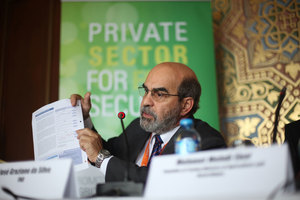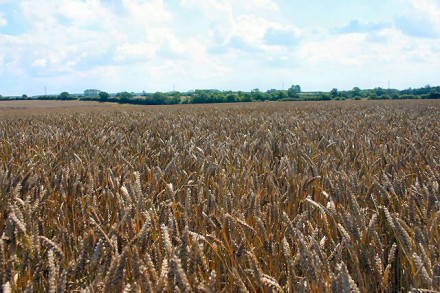By Kevin Robbins
On Sunday mornings at the Dupont Circle FRESHFARM Market in Washington, D.C., you can find bouquets of fresh flowers, bundles of brussels sprouts, and buckets of local apples. And you can also find a man in a white butcher’s smock surrounded by tables of ice and local meats labeled “Designer Line of Fine Swine” and “Grass-kickin’ Chicken.”

Bev Eggleston discusses raising animals humanely. (Photo credit: Gourmet Magazine)
Bev Eggleston—founder of EcoFriendly Foods—invites wondering customers to sample his latest selection of cured meat. He starts out simple: “Have you ever tasted heritage pork?” But before you leave, he’ll get serious: “So why do you think Obama didn’t mention agriculture in his State of the Union address? How can an ‘America Built to Last’ forget about its farmers?”
Eggleston’s grass-fed, family-farm-raised meats are a favorite with farmers’ market shoppers and dinners at some of the best restaurants up and down the East Coast. He owns and operates the first of what he hopes to be many multi-species, certified humane, USDA inspected processing plant in Moneta, Virginia. He works with small, local farms to source, process, and distribute local beef, eggs, lamb, pork, and poultry.
Additionally, Eggleston works with organizations in the profit and not-for-profit sector to promote family farming and sustainable agriculture. He lobbies government locally and nationally and last year joined the Advisory Committee for AGree, a new initiative focused on long-term agricultural, food, and rural policy issues.
This is the first of a two-part interview with Eggleston.
What was the genesis of EcoFriendly Foods? How did you go from farming in Virginia to processing and selling Virginia-farmed meats across the East Coast?
I got into farming after being sick and learning about detox [how what we consume effects our health] and the ecology of [human] physiology. I was interested in the importance of the how and why behind the plants and animals we grow. I got involved in eco-friendly farming which helped both with my healing and my personal growth.
In 1991 I met Joel [Salatin of Polyface Farms] and started learning from him. Back then, we believed that we were farming the right way, but we could produce more than we could sell to folks who came to the farm. We needed to rmake the food more accessible to more people. We needed a bridge from the meadow to the mainstream. We needed to figure out how to get free range chickens into Chipotle, for example. Eventually EcoFriendly was my attempt to build that bridge.
What is ecological profitability? Why is it important to you and your business? What do you think the American food system could learn from this concept?
It’s simple: if it makes ecological sense and it makes profit, then it’s ecological profitability. And it has to be both. We could just be ecologically sound or just economically viable—plenty of people have done that. But ecologically sound while economically profitable? That’s like a lost art form. Thankfully, we’re starting to remember.
Focusing solely on profits and maximizing output—with no regard for the earth, the animals, or the quality of the food we’re putting into our bodies—this kind of thinking has made a mess of our food system and of farming in America. I believe we still have some tough times ahead, but I’m optimistic. I know there’s a new crop of farmers out there who want to learn how to grow food in a way that is ecological and profitable.
What is conscious consumption and why are you a proponent?
People who consume consciously are more aware of their food dollar, of where their money goes, of the power it represents. Consumers can vote their beliefs with their dollars. And the industry knows this, which is why they try to keep consumers in the dark. But the more consumers demand, the higher the aspirations of the American food system will have to be.
Today, there’s no integrity in the American food system. I can tell you this: they’re [the food industry] not focused on your health, your well-being. We have to go to the store and spend half our time scrutinizing labels. That’s crazy!
But we’re learning, and our learning curve is rising fast. As we create more market demand, the industry listens. Right now, we are a niche market. But when we’re successful, there won’t be anything niche about this market. We’re helping the market understand which direction we should be moving in, a better way of growing and selling food.
Are we more powerful as a collective than we are as individuals? The answer is yes, always. Collectively we need to spend our money in ways that will make a difference for ourselves and the environment.
You sell much of your products to restaurants, working with what you have described as “enlightened chefs” who value a combination of sustainability and superior quality. What role do these chefs play in changing our food system.
These chefs are rock stars. They’re heroes. They’re choosing high quality, sustainable products and rejecting much cheaper alternatives. The small family farmer can’t sell to most of the grocery store chains. And they can’t sell to most restaurants. But they can make a living selling to these chefs.
And they’re educating the public. At the farmers’ market, we connect with people every week. But these chefs amplify that message. They reach out to new dinners every day.
The chefs are important, but they can’t do anything without a good front of the house—waiters and waitresses who know how to tell the story. Diners have questions about what tastes good, what’s raised right. This empowers the wait staff to help diners make good, informed decisions. I need the front of the house to deliver the message which is why I spend time working with them when I drop off product for the chefs.
I’ve asked this animal to give its life up to provide sustenance, and I take that fact very seriously. With the help of enlightened chefs and a front of the house that is educated and excited, I know that diners will taste something delicious, learn something new, and feel good about the decision they made. And I’ll know that the animal I delivered did not die in vain.
You predominantly work with small, family farmers and pasture-raised heritage breed animals. Why are they important to you and what role do they play in a sustainable system of agriculture?
Heritage breeds teach us how animals really want to live and you can’t beat their quality or adaptability. Actually, small family farms and heritage breeds are very similar: they both need marketability or they’ll be extinct. Honestly, my biggest commitment to rare breeds is the rare breed of farmer that is young, small, and family-oriented. And I’m willing to do whatever it takes to help those young farmers keep their farms or find farms to call their own.
They’ve got to figure out how to make it in the new farm economy and I think that what they really need to do is think way outside of the box. If you ask me who is the ideal farmer, I say young and hard-working—even urban transplants, people who are new to farming. They’re tabla blanca, clean slate, someone who isn’t prejudiced by the old way of doing things or their fears about tomorrow.
But they’re also going to need some help. The government has to even the playing field. Federal subsidies have propped up large, unsustainable commercial farms and given them an unfair advantage. They’ve sold their products for artificially cheap prices. But this has proven to be bad for the environment, bad for animals, bad for consumers, and bad for family farms.
As opposed to just regulating us, the government needs to invest in us and encourage development. Let’s make sustainable farming a profitable enterprise. We also need new policies. President Obama has mandated that allUSDA programs must emphasize local food. But the USDA has no idea how to answer that call. They barely understand the questions that call creates.
All of us in AGree have been studying or working in agriculture for several decades. It took a long time for the system to spin off in the wrong direction. It’s taken a long time for us to investigate and understand the problems this has created. And it will take a long time for us to craft something new. In AGree, we’re looking at American agriculture 10 to 20 years from now. We know there’s a lot of work to do. But we’re hopeful.
On a practical level, we need to share stories of success so that others will get inspired to change their ways, to get involved. Replicated small successes can make an enormous impact. Part of my generation’s work is to inspire and recruit the next generation of farmers.
To learn more about EcoFriendly Foods’ visit their website or Facebook page.
To read more about family farms and farmers’ markets see: Feeding Mouths and Empowering Communities in Brazil,Family Farmers Get Their Day In Court Against Monsanto, Connecting Farmers to Markets in Mali, and New Report Urges the Government to Invest in Farmers Markets.
Kevin Robbins is a research intern with the Nourishing the Planet project.
To purchase your own copy of State of the World 2011: Innovations that Nourish the Planet, please click HERE. And to watch the one minute book trailer, click HERE.




